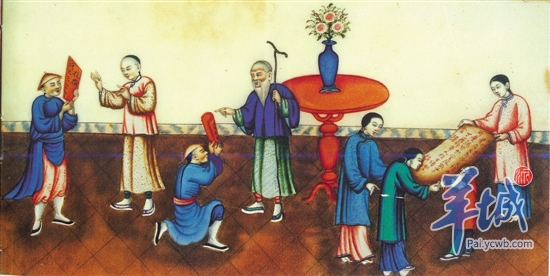 |
|
This Qing Dynasty painting depicts the delivery of an admission letter to a candidate's home. [Photo/Yangcheng Evening News] |
As high school graduates have finished their college entrance exams and filled out the application forms for their desirable colleges, they are now anxiously waiting for admission letters to arrive.
Today's admission letters have become more and more creative with delicate designs. However, do you know how students in ancient times received their admission letters and what the letters were like?
Gold and glittering admission letter
During the Tang Dynasty (618-907), the admission letter was on paper decorated with gold bits, or scraps, to denote those who stood out in the ancient imperial examinations, or keju. The gold notice was sent home by students attached to a letter, instead of through official channels, so some people think this was not an official admission letter.
The widely-recognized official admission letter was called jinhua tiezi (golden flower letter), which appeared later. It was similar to today's admission letters from key national universities.
According to historical records from the Song Dynasty (960-1279), jinhua tiezi was written on top-quality paper sprinkled with powdered gold, which was usually five cun long (about 15 centimeters). Until the Qing Dynasty (1644-1911), woodblock printed admission letters were made.
Admission letters in the Ming (1368-1644) and Qing dynasties were called jiebao, which were larger in size and made for students to put on display in their halls.
Overall, fancier materials were used to make admission letters to candidates with higher grades. Besides paper, some used delicate brocade silk or fine processed wood.
What was written on an admission letter?
The ancient admission letter was always written in clerical script (lishu), an archaic style of Chinese calligraphy. The center of the letter showed the examinee's ranking as well as the year and name of the exam.
During the Tang and Song dynasties, the jinhua tiezi would first list the names, titles and personal information of the main officials in charge of the exam and then the name of the examinee.
The jiebao in the Ming and Qing dynasties had simpler content, which just contained the name and ranking of the examinee.
The ancient admission letters also had to be stamped with special seals after being written. In the Qing Dynasty, the list of successful candidates during the dianshi, the top-level exam in keju, would be sealed by the emperor and shown to the public.
How was an admission letter delivered?
Nowadays, admission letters are delivered by China Post, while in ancient times, delivery of the admission letter involved a very solemn government procedure. A special team would be assembled to deliver the letter, with an official riding on a tall horse, raising up a flag in the front, and a band followed behind playing cheerful music and lighting fire crackers to celebrate.
After receiving the admission letter, the host would give red envelopes containing cash to the delivery men as lucky money. The letter would then be posted in the most prominent position in the hall of the candidate's home as a proud honor.